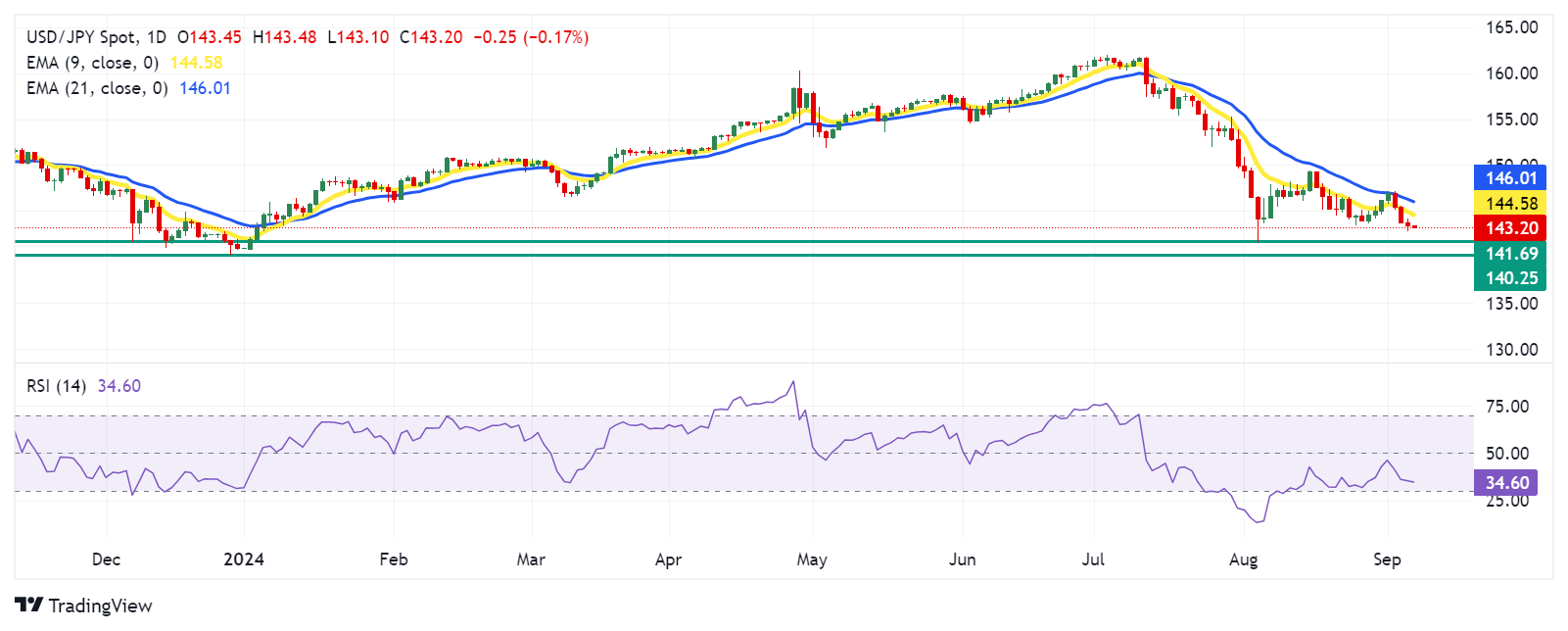Japanese Yen extends winning streak as US Dollar remains subdued due to dovish Fedspeak
- The Japanese Yen appreciated as rising Labor Cash Earnings bolstered the odds of further BoJ rate hikes.
- BoJ’s Takata stated that "if the economy and prices move as expected, we will adjust the policy rate in several stages."
- The US Nonfarm Payrolls report is expected to show 160,000 new jobs in August, up from July’s 114,000.
The Japanese Yen (JPY) continues its winning streak for the fourth successive session as rising real wages in July fuel speculation that the Bank of Japan (BoJ) may introduce another interest rate hike before the end of 2024. Additionally, the USD/JPY pair has encountered headwinds due to a softer US Dollar (USD), driven by dovish comments from Federal Reserve (Fed) officials.
Bank of Japan (BoJ) Board Member Hajime Takata stated on Thursday that "if the economy and prices move in line with our forecast, we will adjust the policy rate in several stages." Takata also mentioned that the domestic economy is recovering moderately, despite some signs of weakness. While stock and FX markets have experienced significant volatility, he noted that the BoJ still sees the achievement of its inflation target within reach.
Traders are likely to await Friday's release of labor market data, including the US Nonfarm Payrolls (NFP), to gather further insights on the potential size of an anticipated rate cut by the Federal Reserve (Fed) this month.
Daily Digest Market Movers: Japanese Yen extends upside due to hawkish mood surrounding the BoJ
- Chicago Fed President Austan Goolsbee said on Friday that the longer-run trend of the labor market and inflation data justify the Fed easing interest-rate policy soon and then steadily over the next year. FXStreet’s FedTracker, which gauges the tone of Fed officials’ speeches on a dovish-to-hawkish scale from 0 to 10 using a custom AI model, rated Goolsbee’s words as neutral with a score of 3.8.
- ADP Employment Change showed on Thursday that private-sector employment increased by 99,000 in August, following July’s increase of 111,000 and below the estimate of 145,000. Meanwhile, the weekly US Initial Jobless Claims rose to 227,000 for the week ending August 30, compared to the previous reading of 232,000 and below the initial consensus of 230,000.
- Japan’s Labor Cash Earnings grew by 3.6% year-on-year, a deceleration from June's 4.5% increase but the highest since January 1997, surpassing market expectations of 3.1%.
- San Francisco Federal Reserve President Mary Daly stated on Wednesday that "the Fed needs to cut the policy rate as inflation is declining and the economy is slowing." Regarding the size of the potential rate cut in September, Daly noted, "We don't know yet." FXStreet’s FedTracker, which gauges the tone of Fed officials’ speeches on a dovish-to-hawkish scale from 0 to 10 using a custom AI model, rated Daly’s words as neutral with a score of 3.6.
- Atlanta Federal Reserve President Raphael Bostic said that the Fed is in a favorable position but added that they must not maintain a restrictive policy stance for too long, per Reuters. FXStreet’s FedTracker, which gauges the tone of Fed officials’ speeches on a dovish-to-hawkish scale from 0 to 10 using a custom AI model, rated Bostic’s words as neutral with a score of 4.6.
- Japan’s Chief Cabinet Secretary Yoshimasa Hayashi stated on Wednesday that he is "closely monitoring domestic and international market developments with a sense of urgency." Hayashi emphasized the importance of conducting fiscal and economic policy management in close coordination with the Bank of Japan (BoJ).
- US JOLTS Job Openings dropped to 7.673 million in July, down from 7.910 million in June, marking the lowest level since January 2021 and falling short of market expectations of 8.10 million.
- Jibun Bank Services PMI data on Wednesday. The index was revised to 53.7 in August from an initial estimate of 54.0. Although this marks the seventh consecutive month of expansion in the service sector, the latest figure remains unchanged from July.
Technical Analysis: USD/JPY falls toward 143.00, followed by seven-month lows
USD/JPY trades around 143.30 on Friday. A daily chart review shows that the nine-day Exponential Moving Average (EMA) remains below the 21-day EMA, indicating a persistent bearish trend. Additionally, the 14-day Relative Strength Index (RSI) is near the 30 level, reinforcing the bearish momentum but also hinting at the possibility of an upward correction soon.
In terms of support, the USD/JPY pair is falling toward the seven-month low of 141.69, recorded on August 5. Additional key support appears at 140.25, which is the lowest level since July 2023.
On the upside, the USD/JPY pair might first encounter a barrier at the nine-day EMA around 144.60, followed by the 21-day EMA at 146.02. A break above these EMAs might weaken the bearish sentiment and push the pair toward the psychological level of 150.00.
USD/JPY: Daily Chart

Japanese Yen PRICE Today
The table below shows the percentage change of Japanese Yen (JPY) against listed major currencies today. Japanese Yen was the strongest against the Australian Dollar.
| USD | EUR | GBP | JPY | CAD | AUD | NZD | CHF | |
|---|---|---|---|---|---|---|---|---|
| USD | -0.02% | 0.01% | -0.19% | -0.05% | 0.12% | 0.14% | -0.06% | |
| EUR | 0.02% | 0.03% | -0.19% | -0.04% | 0.14% | 0.14% | -0.04% | |
| GBP | -0.01% | -0.03% | -0.21% | -0.05% | 0.12% | 0.12% | -0.07% | |
| JPY | 0.19% | 0.19% | 0.21% | 0.16% | 0.33% | 0.31% | 0.12% | |
| CAD | 0.05% | 0.04% | 0.05% | -0.16% | 0.16% | 0.19% | -0.02% | |
| AUD | -0.12% | -0.14% | -0.12% | -0.33% | -0.16% | -0.00% | -0.20% | |
| NZD | -0.14% | -0.14% | -0.12% | -0.31% | -0.19% | 0.00% | -0.20% | |
| CHF | 0.06% | 0.04% | 0.07% | -0.12% | 0.02% | 0.20% | 0.20% |
The heat map shows percentage changes of major currencies against each other. The base currency is picked from the left column, while the quote currency is picked from the top row. For example, if you pick the Japanese Yen from the left column and move along the horizontal line to the US Dollar, the percentage change displayed in the box will represent JPY (base)/USD (quote).
Japanese Yen FAQs
The Japanese Yen (JPY) is one of the world’s most traded currencies. Its value is broadly determined by the performance of the Japanese economy, but more specifically by the Bank of Japan’s policy, the differential between Japanese and US bond yields, or risk sentiment among traders, among other factors.
One of the Bank of Japan’s mandates is currency control, so its moves are key for the Yen. The BoJ has directly intervened in currency markets sometimes, generally to lower the value of the Yen, although it refrains from doing it often due to political concerns of its main trading partners. The current BoJ ultra-loose monetary policy, based on massive stimulus to the economy, has caused the Yen to depreciate against its main currency peers. This process has exacerbated more recently due to an increasing policy divergence between the Bank of Japan and other main central banks, which have opted to increase interest rates sharply to fight decades-high levels of inflation.
The BoJ’s stance of sticking to ultra-loose monetary policy has led to a widening policy divergence with other central banks, particularly with the US Federal Reserve. This supports a widening of the differential between the 10-year US and Japanese bonds, which favors the US Dollar against the Japanese Yen.
The Japanese Yen is often seen as a safe-haven investment. This means that in times of market stress, investors are more likely to put their money in the Japanese currency due to its supposed reliability and stability. Turbulent times are likely to strengthen the Yen’s value against other currencies seen as more risky to invest in.

